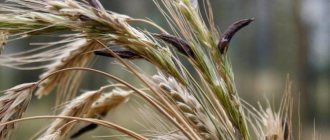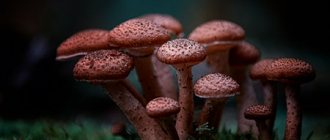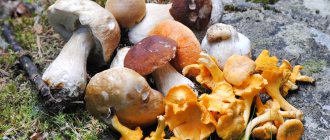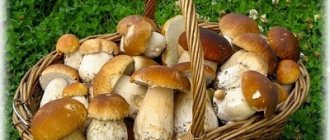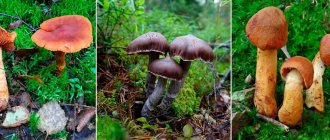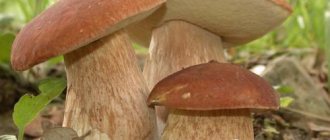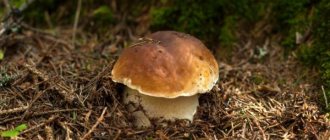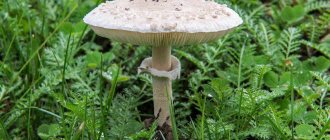Mushrooms occupy an important place in human life. Without penicillin and yeast, our existence would be more difficult. The tradition of eating them is not widespread in all countries, since they are a difficult product for digestion. There are more than 100,000 species, some of which are dangerous to humans.
There are no accurate global statistics on the number of people affected by mushrooms. So it is impossible to say for sure which of them is the most dangerous, with complete certainty. Even spoiled pickled edible mushrooms pose a threat. At the slightest suspicion, they should be thrown out; in extreme cases, simmer over low heat for at least 30-40 minutes. Botulinum toxin, which is destroyed under such conditions, is one of the most toxic substances in the world and was previously used as a biological weapon.
In addition, they can absorb harmful substances, so you should not pick mushrooms near roads and industrial facilities. Some participants in the list of the 10 most poisonous mushrooms in the world do not lose their dangerous properties even during heat treatment. And drinking alcohol only worsens the situation in case of poisoning, despite prevailing opinions. So the main rule is: “Don’t try unfamiliar mushrooms!”
10. Waxy talker
The waxy talker is rare. But at the same time, it has a pleasant taste and is similar to edible cherries. Its main difference is the presence of watery circles on the cap. Waxy talker contains the substance muscarine, which is found in fly agarics and other types of talkers. Symptoms of poisoning appear within 20-30 minutes. These are vomiting, abdominal pain, confusion, etc. Depending on the situation, the lethal dose is from 10 to 80 grams of this mushroom.
Spring mushroom picking season in Ukraine
The first spring mushrooms most often appear in forest areas located on both sides of the Kyiv Sea. It is here that chanterelles, boletus, white and saffron milk caps, as well as russula, from which, as a rule, only the caps are collected, appear to replace the strings, morels, oyster mushrooms and rows. Under favorable weather conditions, in the last ten days of spring, the May or St. George mushroom appears, as well as boletus and other most unpretentious and widespread spring-summer varieties of edible mushrooms.
9. Amanita stinking
Approximately half of cases of stinking fly agaric poisoning are fatal. It is difficult to confuse it with edible mushrooms. But young specimens of this species are similar to champignons, from which they differ in their unpleasant odor and the presence of a volva (a sac-like covering located at the very base of the fruiting body of the mushroom), often hidden in the ground. With increased humidity, this fly agaric begins to secrete mucus, which does not add to its attractiveness. Signs of poisoning appear within half an hour. This includes profuse sweating, fever, drooling and vomiting. If medical assistance is not provided in time, death most often occurs from cardiac arrest.
Mushroom places in Ukraine
In recent years, mushroom tourism has become especially popular, which involves not so much the cultivation of edible species, but the collection of forest varieties with very high nutritional value. Popular mushroom spots among mushroom pickers include:
- Carpathian region, represented by massifs between rivers on the border of such regions as Lviv and Ivano-Frankivsk. On the territory of the Skole Beskids nature reserve, consisting of beech conifers, more than five dozen species of edible mushrooms grow, including porcini and boletus, russula, boletus and honey mushrooms. The best places for collecting mushrooms are the surrounding areas near the villages of Oriv, Tukhlya, Oryavchik and Grebennoye. The average distance from Lviv is just over one hundred kilometers;
- Carpathian highlands, represented by elevated areas of mountainous and wooded terrain. In this regard, forest areas near the village of Verkhovyna in the Ivano-Frankivsk region are perfect for “silent hunting,” where porcini mushrooms, chanterelles, boletus and russula grow in abundance. Experienced mushroom pickers go to collect mushrooms in Mykulychyn or Yablunytsia, which can be reached not only by private car, but also by public or tourist transport;
- Bukovyna in the Chernivtsi region, represented by vast beech forests, is a real paradise for experienced mushroom pickers and simple amateurs. It is here that the highest yield of very large porcini mushrooms is recorded annually. Among the settlements included in numerous modern ecotourism trails are the villages of Sergii and Zelenaya, as well as Vizhenka. Organized ecotourism is based on a “silent hunt” accompanied by an experienced guide who is able to show the best mushroom spots;
- The Lviv region is rich in boletuses, boletuses, honey mushrooms and porcini mushrooms, which grow in abundance in the wooded mountainous areas in the Starosambir, Turkiv and Skole districts near the villages of Skhidnytsia, Slavskoe and Likhobora;
- The Ternopil region, including the Monastyrsky and Shumsky districts, is characterized by active fruiting of porcini mushrooms and honey mushrooms, and boletus and boletus mushrooms grow in the Mshanetsky forests, as well as boletus. It is recommended to go to the Kremenets Mountains to collect boletus mushrooms;
- The Cherkasy region, where a large number of large forests are concentrated, is famous for porcini and boletus mushrooms. Close to Kanev there is the famous Buchatsky forestry, which has become very popular due to the annual and very abundant fruiting of honey mushrooms.
It is also worth noting the abundance of mushrooms in forests located near the regional center of Kelmentsi, in the vicinity of Lake Synevyr and near the villages of Lumshory, Dragovo and Vyshka, as well as Kolochava. Mushroom abundance is observed in remote villages of Svalyavsky and Mukachevo regions.
8. Mountain gossamer (plush)
This member of the list of the 10 most poisonous mushrooms in the world is very insidious. The effect of its toxins begins to manifest itself after a long period of time, from 2 to 24 days, most likely leading to death. Therefore, until the 1960s, it was considered edible, and only a whole series of poisonings with it forced scientists to carefully study the composition. This mushroom is found in Europe, Ukraine and Russia. It is very difficult to distinguish it from other varieties of spider webs, so it is easier not to collect them at all.
7. Patouillard fiberglass
This mushroom is one of the most dangerous mushrooms on the planet from the entire genus of Fibers. Most often found in deciduous and mixed forests of Europe and Asia, in the European part of Russia and the Caucasus. It is usually confused with russula and champignons, which leads to poisoning. Deterioration of vision, chills, vomiting and other signs appear within 20-30 minutes. A person can die if first aid is not provided in time. This effect is given to mushrooms by the substance muscarine, which is also found in red fly agarics. But in the Patuillard Fiber there is about 20 times more of it.
Sulphur-yellow false honey fungus
Sulphur-yellow false honey fungus is a very poisonous mushroom found on all continents except Africa and Antarctica. They grow on old stumps of deciduous and coniferous trees in August-November. When eaten, the mushroom causes severe, sometimes fatal poisoning. Symptoms appear within a few hours and are accompanied by abdominal pain, nausea, vomiting, sweating, diarrhea and bloating, sometimes blurred vision and even paralysis.
4
6. Panther fly agaric
Compared to the red fly agaric, it has a less striking appearance. So it may well be confused with edible mushrooms. This is especially true for young specimens. It is so poisonous that there are usually no insects near it. The amount of muscarine and muscaridine in it is several times greater than in the red fly agaric. In addition, it contains other dangerous substances: scopolamine, hyoscyamine. For these reasons, the Panther Amanita is included in the ranking of the most poisonous mushrooms on the planet. Most often, eating these mushrooms leads to death due to paralysis of the respiratory muscles and cardiac arrest.
Pig
Pig mushrooms were included in the list of poisonous mushrooms only in 1944. Before this, they were considered conditionally edible. The fact is that they contain a special antigen that sticks to our red blood cells, thereby causing an autoimmune response in the body. As a result, a person develops hemolytic anemia, renal failure, and nephropathy. For this to happen, pigs need to be eaten for a long time (until their antigens accumulate in sufficient quantities).
Many people, having eaten them once, do not experience any painful symptoms, so no one associates the death with the pig. Death most often occurs in children and people with kidney problems. Externally, the mushroom is quite nice and very similar to a good one. It has a thick short leg, a fleshy large cap (up to 15 cm in diameter), which can be slightly convex or flat. Its color varies from olive-brown to rusty-brown. The pulp at the site of damage (pressure) quickly darkens. You can often see worms and insects in it. Using the example of a pig, we can say that the signs of poisonous mushrooms do not always work. If you focus only on whether the caps are wormy or not, you can make a fatal mistake.
5. The spider web is beautiful
The genus of spider webs includes about 40 species of mushrooms, only some of which are edible. They are similar to each other, so it is better to pass them by if you cannot reliably determine the edibility of the mushroom. The beautiful cobweb contains orellanin. It destroys the kidneys, lungs and musculoskeletal system. Moreover, symptoms usually appear one or two weeks after poisoning, when the changes are irreversible, leading to death even with medical care. This mushroom is found quite rarely, mainly in coniferous damp forests, especially on the outskirts of swamps.
4.Framed gallery
On the fourth line in the ranking of the most dangerous and poisonous mushrooms on the planet is Galerina fringed. It is dangerous primarily due to its similarity to the edible summer mushroom and is capable of deceiving even experienced mushroom pickers. In Russia, the fringed galerina began to appear more often due to climate change. Before this, it was found in countries where very few mushrooms are collected: Japan, North America, Iran. It grows mainly in coniferous forests, so to be on the safe side, it is better not to collect honey mushrooms in them at all. Moreover, it may well find its way into a cluster of edible mushrooms, so care should be taken when collecting them. Symptoms of galerina fringe poisoning are thirst, the appearance of convulsions, etc. They appear 10-14 hours after it enters the body. The greatest damage is caused to the liver; without timely medical care, there is a high probability of death.
Ergot purpurea
Ergot purpurea is a special type of macromycete that parasitizes cereals. The purple growths resemble fangs. In Russia, growths on rye were called “uterine horns.” When harvesting grains, they got into the bread and caused poisoning. Currently, damage caused by purpurea ergot poisons is rare. They end up in flour when organoleptic control is not carried out.
In the Middle Ages, damage to purple ergot alkaloids was widespread. They went down in history as epidemics caused by the “fire of St. Anthony.”
Currently, mushrooms are found only on wild cereals. After treating fields with herbicides, fungal spores die. Ergot purpurea is extremely rare in developed countries. Modern methods have made it possible to almost completely get rid of ergot.
3. Lepiota brown-red
The unsightly appearance of this mushroom most often forces mushroom pickers to simply pass by it. But still, cases of poisoning are recorded, and half of them end in human death. Lepiota brown-red is extremely poisonous; one cap is enough to produce a lethal dose of toxins. It contains cyanides and nitriles, for which there are no specific antidotes. The first signs of poisoning appear within 10 minutes, and within half an hour a person can die from cardiac arrest. Most often, the ambulance simply does not have time to get there during this period. Some sources claim that the main distinguishing feature of this mushroom is its smell, similar to the aroma of orange syrup.
2.Bleeding tooth
This mushroom certainly cannot be confused with others. It is also called the devil’s tooth, and in appearance it simultaneously resembles a confectionery product and an ordinary mushroom, splattered with blood. The Bleeding Tooth is found mainly in Europe and North America, but it can also occasionally be found in our forests. It feeds on both substances from the ground and insects attracted by its sap. In the future, it may find use in medicine, as it has antibacterial properties and thins the blood. Some sources claim that just licking it is enough to get a lethal dose of toxins, so it is one of the most poisonous mushrooms in the world.
1.Pale grebe
Pale toadstool is the most poisonous mushroom in the world . It rightfully ranks first among the most dangerous mushrooms on the planet. Compared to other mushrooms, it is the toadstool that kills the most people in the world. This is due to its similarity to many edible mushrooms: champignons, russula, etc. It contains several toxic substances. Symptoms of poisoning appear within 6 to 24 hours. Usually these are vomiting, colic, muscle pain and diarrhea. Just 30 grams of this mushroom is enough to cause serious consequences for adults and guaranteed death for children.
The picture of poisoning with toadstool is characterized by a false period of relief. After a few days, the symptoms disappear and the person thinks that everything has passed. At this time, the destruction of the body continues. It is better to refrain from collecting young champignons, since it is extremely difficult to distinguish them from the toadstool.
Conditionally edible and poisonous mushrooms
Edible mushrooms are white mushrooms, boletus mushrooms, boletus mushrooms, etc., well known to experienced mushroom pickers.
They do not contain toxins, have no bitterness or unpleasant odor. Immediately after collection, they can be boiled or fried and eaten. There is also a group of inedible mushrooms. They do not contain harmful substances, but have a bitter taste and unpleasant odor. Eating them does not cause poisoning, but may cause mild stomach upset. Inedible mushrooms include, for example, bitter or gall mushrooms, false chanterelles, vomiting russula, etc.
Gorchak, aka Gall mushroom, is very similar to boletus
Poisonous mushrooms include mushrooms that contain toxins that cause poisoning. Such mushrooms retain their qualities after any type of processing: boiling, soaking, salting, drying, etc. About 25 types of mushrooms are considered the most dangerous. Among them are the stinking fly agaric and panther fly agaric, the pale toadstool, Patouillard's fiber, some types of umbrellas and talkers. Of course, you need to know these mushrooms by sight in order to avoid dangerous mistakes when collecting.
